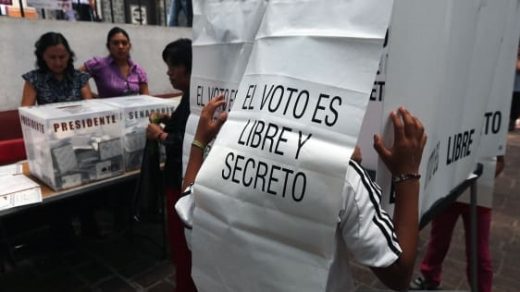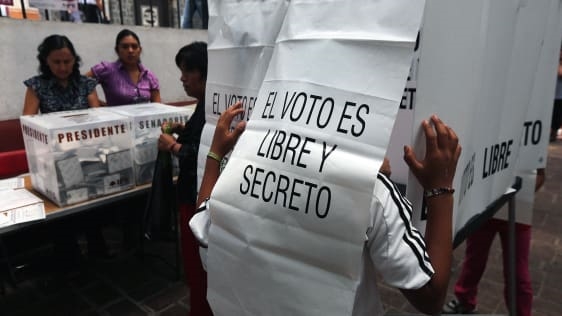To See The Future Of Social Media Manipulation In Politics, Look To Mexico
Many Americans first learned about the role of online bots in influencing elections in 2016, when Russia-linked software reportedly spread disinformation to boost President Trump’s campaign.
But just across the Mexican border, automated software has been deployed to influence political opinion for the better part of a decade. As early as the country’s 2012 general election, Twitter was swarmed with apparent automated accounts supporting now-president Enrique Peña Nieto. Hacker-for-hire Andrés Sepúlveda claimed in a 2016 Bloomberg Businessweek interview that he managed a budget of $600,000 to digitally sway the election toward Peña Nieto, hacking rivals’ networks and deploying an army of at last 30,000 bots to artificially generate trends on Twitter.
“It’s surprising to me,” says Oxford researcher Sam Woolley, “that in the United States we didn’t look to our southern border to see what might happen during our 2016 election.”
And more recently, most observers say all parties in Mexico have used bots to promote their own messages online and promote their opponents, whether by flooding opponents’ hashtags with meaningless spam, impersonating supporters of rival factions to post extremist content, or even issuing out-and-out threats. Those are hard not to take seriously in a country that a Committee to Protect Journalists report last May called “one of the most dangerous countries in the world for the press” and where activists are routinely killed.
“I think what the bots have done a lot of time is to frighten people, not just regular citizens, but also journalists, in an effort to cause chilling effects,” Woolley says.
A general election to choose the term-limited Peña Nieto’s successor is scheduled for July 1, and experts have already warned that bots and trolls will likely be heavily deployed from all sides, in a country where a high level of internet access and a history of corruption made it a frequent testbed for digital manipulation techniques often later seen elsewhere. U.S. national security advisor H.R. McMaster warned in December there are signs of Russian meddling in the election through online propaganda, and experts say domestic bots continue to be a powerful force in Mexican politics, signaling false levels of support for candidates and drowning out their rivals in online conversations.
“There is a lot of examples but the most recent and important to me is when Obama [visited Mexico in 2014] and bots erased all the [Twitter trending topics] protesting against the visit,” says Alberto Escorcia, an activist who has tracked Mexican political influence bots since 2012, in an email to Fast Company. “And [then] last January when the people were protesting against the increase of gasoline and oil prices.”
In that case, bots are believed to have spread false reports of violent looting in an effort to turn the public against the protesters and their cause.
Bots have also been implicated in the fierce rivalries between Mexican broadcasters. Last September, after the deadly earthquake in central Mexico, newscasters, especially those with TV giant Televisa, reported on a girl named Frida Sofia who was reportedly trapped under the rubble. Naval officials initially said rescuers were in contact with the girl, then admitted she never existed.
Rival TV network Azteca quickly aired an episode of “The Simpsons” where Bart plays a similar hoax, and anti-Televisa hashtags began trending. According to multiple reports, including a third-party analysis obtained by Fast Company, anti-Televisa messages and memes were boosted by accounts usually associated with Azteca productions and, likely, with the aid of bots. (According to some reports, pro-Televisa bots subsequently helped drive the most prominent critical hashtag from social media trending lists).
And when it comes to foreign influence, Russians aren’t the only outside players believed to be interested in the election. Cambridge Analytica, the data-driven campaign firm that has worked with Donald Trump and Ted Cruz, has posted job ads in advance of this year’s elections in Mexico. It’s also signed a deal with Pig.gi, a company that offers free, ad-sponsored internet service in Mexico, which could let it deliver highly targeted, data-driven campaign messages to Pig.gi’s hundreds of thousands of users in Mexico.
Cambridge Analytica is believed to have been particularly effective at using carefully demographic targeted social media posts to help sway U.S. voters to Donald Trump in 2016. But whatever role it takes in the Mexican election, it likely won’t be the only organization trying to learn from Trump’s unexpected digital success.
“There are many companies that are trying to do this,” says Paola Villarreal, an engineer and activist who has written about bots in Mexican politics.
Candidates are likely to use bots this year to alienate supporters of their political rivals as much as to energize supporters and woo new voters, she says.
“I guess the use of the bots in the Mexican election is going to be more to demoralize and demobilize the electorate, instead of making them vote for someone,” Villarreal says.
That could include impersonating unhappy citizens saying they don’t intend to vote, supporters of particular candidates claiming to defect to a rival, or even representatives of political parties implying they’re sure to win in a landslide.
“They can definitely start to say ‘oh, thank you for supporting us–we no longer need you,’” she says.
For its part, Twitter says it’s taking steps to promote meaningful political discourse on its platform in advance of the election.
“First, we have set up an alliance with the NGO Jóvenes en Movimiento and the Tec of Monterrey University, to educate both parties and voters on best practices to inform, consume, and debate electoral information on Twitter,” a Twitter spokesperson writes in an email to Fast Company. “Through these workshops we aim to explain that the power of platforms like Twitter is both to inform people but also to engage with the audience, question policy proposals, and thus help to have a better informed citizenry.”
The spokesperson also pointed to the company’s ramped-up efforts to shut down “malicious automation,” which identified than 6.4 million suspicious accounts per week in December 2017–up 60% from October.
But in state elections last year, Villarreal says, bots and trolls turned in part from newsfeed-based social media–where people have learned to be distrustful and which some prominent activists, journalists and others have moved away from after attacks from trolls–to one-on-one tools like WhatsApp and ordinary text messages.
“It’s not only social media–it’s whatever and wherever people are paying attention,” she says.
Already, misinformation campaigns have been spotted on popular messaging platforms around the world, including in the days leading up to last year’s contested election in Kenya and gubernatorial vote in Jakarta, Indonesia. And should they prove successful in Mexico, experts say it’s likely they’ll be seen around the world before long.
Fast Company , Read Full Story
(11)














